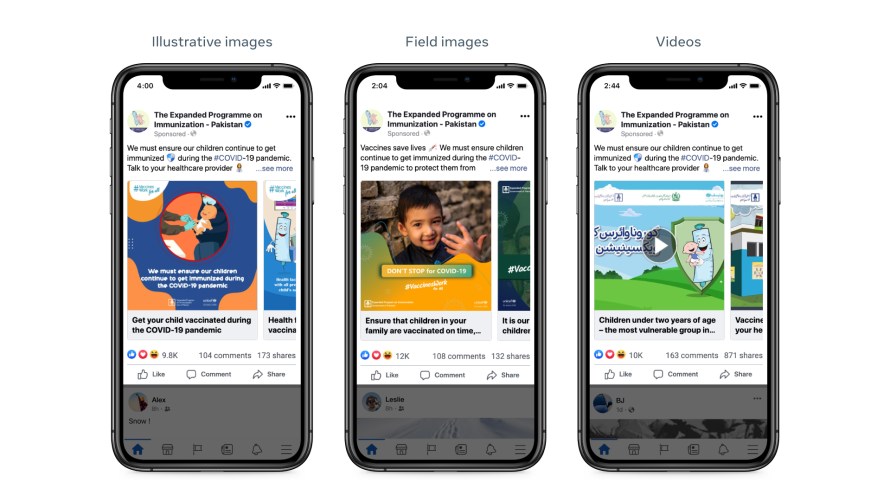The ongoing COVID-19 pandemic has increased awareness around vaccine hesitancy, which refers to people’s reluctance or refusal to accept vaccinations, despite their availability. In 2019, the World Health Organization (WHO) described vaccine hesitancy as one of the top 10 threats to global health, saying that the issue threatened to reverse the progress made in tackling preventable disease. The pandemic has also disrupted the delivery of lifesaving routine immunization services for children in many countries.
As part of World Immunization Week, we are sharing the results of our partnership with UNICEF to help combat vaccine hesitancy and increase routine immunization rates. Over the last nine months, we analyzed engagement with digital campaigns about vaccines in six countries that are home to over two billion people: Brazil, India, Kenya, Nigeria, Pakistan and Ukraine. Through our Insights for Impact program, we worked with UNICEF to analyze public Facebook posts about vaccines in each country. We tested the effectiveness of different content, messages and messengers in positively shifting knowledge and perceptions of vaccines and willingness to vaccinate. Across all these campaigns, we put vaccine information in front of more than 102 million people. We hope to release a detailed report at a later date, but our early findings suggest that health-care workers make powerful spokespeople and that authoritative, informative messaging is more effective than emotional messaging.
The most successful strategy varied from region to region. In India, a campaign featuring a doctor talking about his decision to vaccinate his own children led to a notable increase in the numbers of people who said that routine immunization was important. But in Kenya, a straightforward message and an infographic with the recommended vaccination schedule appeared to be most effective.
How We Did It
We were able to measure the effectiveness of UNICEF’s digital campaigns to build vaccine confidence by comparing two different groups’ responses to a survey on Facebook. One group saw the ads, and the other did not. If we saw that people in the former group were more likely to submit desired responses to the survey and the difference was statistically significant, then we could determine that the ads were effective. In all cases, we asked respondents whether they remembered seeing an ad from UNICEF recently, as well as up to four other questions relating to awareness, attitude, and willingness to vaccinate.
Responses to the survey suggested that the content and style of the message are crucial when it comes to engagement. For example, both the “Vaccine Effectiveness” and “Vaccine Safety” campaigns in Brazil achieved healthy numbers of ad recall, possibly because they depicted Monica, a popular cartoon ambassador in the country. And in Pakistan, illustrative images depicting animations on immunization with guidance delivered favorable outcomes in terms of ad recall, awareness, attitude and willingness to vaccinate. That’s because the illustrations seemed to strike the right balance in terms of being both engaging and instructive.
However, colorful content is not a panacea for vaccine hesitancy. Video content in Pakistan did not achieve a statistically significant positive impact on ad recall or other key campaign objectives. And even Brazil’s Monica had her limits: She failed to positively shift attitudes on vaccine safety. This is in line with 2014 research suggesting that messages that refute side effects and promote safety can backfire when directed at vaccine-hesitant populations. With our survey data showing that the majority of vaccine-hesitant people are fearful of side effects, future research should consider developing effective ways to address issues around side effects through different frames. In Pakistan’s case, campaigns also need to be instructive in order to maximize effectiveness. We also identified a big opportunity for organizations promoting vaccine confidence to drive people to trusted sources of health information beyond digital campaigns.
It’s not just the content itself — the tone of the message also matters. We compared the effectiveness of three messaging approaches in three countries: authoritative, emotional and informative. Authoritative messaging emphasized the guidance of health authorities on continuing vaccination, emotional messaging depicted parents with their children, and informative messaging relied on infographics with the vaccination schedule.
The authoritative approach yielded the best results in Nigeria and Ukraine. These results echo research published by the University of Maryland: Respondents to a survey said they were most likely to get vaccinated against COVID-19 if it were recommended by authoritative sources like the WHO and local health-care workers. In India, health-care workers, peer influencers (such as parents who are doctors) and faith leaders showed particular promise in this regard. Kenya was an outlier: There, people appeared to be more confident about vaccines after reading informative campaigns.
Whatever the style, content and deliverer of the message, one thing was clear from the analysis: Using ads to link people to resource pages where they can get more information on child immunization can lead to stronger campaign outcomes.
This isn’t the first time we’ve utilized Facebook tools to improve vaccination outcomes. For several years, Facebook data scientists have been applying machine learning techniques to publicly available population data and commercially available high-resolution satellite imagery to map where people live across the entire globe. With guidance from our population density maps, Red Cross volunteers in Malawi were able to locate communities to help answer questions about the vaccination process and address the concerns of those who otherwise might not have brought their children to be immunized. We’ve recently updated these population density maps to make them even more accurate and hope that they prove useful for COVID-19 vaccine distribution.
We hope these learnings and insights will help inform campaigns aimed at increasing vaccine confidence during the COVID-19 pandemic and beyond.
























